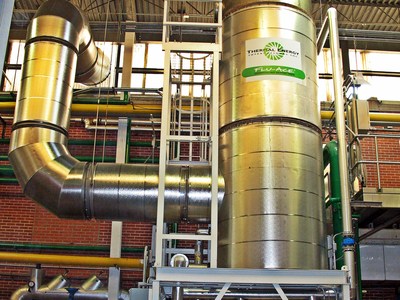|
The healthcare sector is increasingly struggling to address serious maintenance concerns within its estates. Backlog maintenance, also known as deferred maintenance, is overdue essential work required to bring a building or asset up to standard and includes everything from updates to the building fabric, to the condition of the equipment used within it.
In the UK, backlog maintenance is one of the most pressing issues facing the NHS and elsewhere, facilities managers and providers in Canada, America and Europe face site bills that run into the millions. So, what are the options for hospitals looking to reduce their backlog bill? Full steam ahead Heating and hot water systems are some of the largest maintenance drains on a Hospital. Everything, from the heat sources, be it Boilers, CHP or heat pumps, to the pipework and heat exchangers need to be maintained. Such systems are vital to the running of a Hospital and applications such as heating, Domestic Hot Water (DWH) for washing and cooking, sterilization and laundry all rely on well-maintained equipment. Put simply; without an effective heating and hot water system, a Hospital cannot function – putting patients and staff at risk. Steam remains one of the most effective ways of transporting large quantities of heat energy around a Hospital. It has several advantages over other heating technologies, such as Medium Temperature Hot Water (MTHW), and many sites, especially bigger hospitals with a large footprint, use steam to provide hot water, space heating and sterilization services where needed. With this in mind, one of the simplest solutions to minimizing the maintenance bill is to address the steam system. Why does steam maintenance matter? Within any steam system, maintenance is paramount. Recognizing and avoiding leaks ensures a system runs efficiently and safely, with optimal fuel use. Effective steam trapping is key since failed traps not only waste energy, they can also result in live steam loss or water hammer. In the case of water hammer, instead of condensate being safely discharged, it powers through a system causing noise and seriously damaging pipework which can have dangerous consequences. Due to their moving parts, mechanical steam traps are subject to failure, breakdown and wear and tear. With an average annual failure rate of between 5 – 10%, traditional steam traps are a real contributor to a site’s backlog maintenance bill with some having hundreds of traps needing to be surveyed and replaced. GEM – a permanent solution In a hospital of 400 beds the hourly steam requirement is around 3mW, requiring 150 steam traps on site. Each year, an average of 10% of these fail – costing the estate £5,000 ($8,000 CAD) in maintenance each year. Without regular review, over five years this bill can grow to over £25,000 ($42,000 CAD), and cause major downtime of the heating and hot water systems. In response, an increasing number of hospitals are turning to GEM Steam Trap technology in an approach that permanently solves reoccurring maintenance issues and eliminates backlog maintenance caused by unreliable mechanical steam traps. The GEM Steam Trap uses an orifice and multi-staged throat design to manage condensate flow rate. Instead of opening and closing, it harnesses flash steam to create a condensate seal which allows condensate to continuously discharge from the trap at variable rates, without the loss of live steam. Each GEM Trap comes with a 10-year performance guarantee which reduces maintenance costs since annual spend on new steam traps is minimized (or removed entirely) and less time and effort is required to maintain the system. Once installed, GEM Traps are easily maintained and serviced. With no moving parts to break or fail, maintenance and operations professionals are able to prioritize other areas of deferred maintenance not relating to steam traps, further decreasing the backlog. To find out how steam system efficiencies can reduce your backlog maintenance contact us for more information.
0 Comments
Heat Recovery Technology a Great Fit for Hospitals Looking to Cut Energy Bills and GHG Emissions3/26/2018 Earlier today we announced that we received an order from a teaching hospital for one of our proprietary FLU-ACE® heat recovery systems. The FLU-ACE condensing heat recovery system is to be installed on the exhausts from two existing hot water boilers and one CHP. The waste heat will be used to generate hot water for use in hydronic heating and domestic hot water.
Based on our analysis of the information gathered on site, we expect the FLU-ACE system to provide the teaching hospital with annual savings of approximately $220 thousand, while reducing greenhouse gas emissions by 1,007 tonnes per year. Hospitals are very energy-intensive facilities In terms of Btu per square foot, inpatient health care facilities are the second most energy-intensive facility type across the United States, according to the Energy Information Administration. Just what makes them so energy-intensive? Well for starters, hospitals are open 24 hours a day and are occupied by hundreds or thousands of employees, patients, and visitors. They tend to have sophisticated heating, ventilation, and air conditioning systems to control temperatures and air flow. Moreover, many energy-intensive activities occur in hospitals: laundry, medical and lab equipment use, sterilization, food service, refrigeration, and computer and server use. Why FLU-ACE is a smart choice for hospitals About 15% to 20% of the energy used in a boiler plant is lost up the boiler stack. FLU-ACE is a direct contact condensing heat recovery system that recycles the heat normally lost through the boiler flue gas exhaust. It effectively recovers this waste energy and uses it to preheat a heat sink – this could be water for your space heating, domestic hot water, boiler feed water, or outside air heating. By replacing the existing load with our recovered energy, many hospitals have been able to prove savings of 20% on their fuel bills. Be sure to check out our case studies showing the proven benefits of our energy efficiency solutions for hospitals. |
Archives
August 2021
Categories
All
|





 RSS Feed
RSS Feed